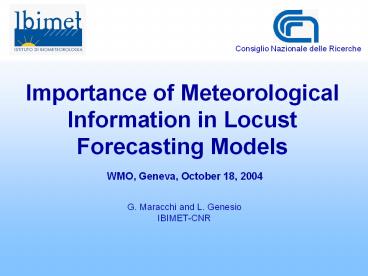Importance of Meteorological Information in Locust Forecasting Models - PowerPoint PPT Presentation
1 / 44
Title:
Importance of Meteorological Information in Locust Forecasting Models
Description:
Importance of meteorological parameters in desert locust cycle ... The high inter annual variability in locust infestation is mainly due to the ... – PowerPoint PPT presentation
Number of Views:134
Avg rating:3.0/5.0
Title: Importance of Meteorological Information in Locust Forecasting Models
1
Importance of Meteorological Information in
Locust Forecasting Models
Consiglio Nazionale delle Ricerche
WMO, Geneva, October 18, 2004
G. Maracchi and L. Genesio IBIMET-CNR
2
Biological cycle of desert locustSchistocerca
gregaria (Forskal).
hatching
Eggs
Hopper (5 juvenil stages)
Gregary egg laying 80 eggs
Solitary egg laying 90-150 eggs
migration
Solitary Adult
Gregary Adult
swarms
3 to 5 generations per year in Africa
3
Recession
Plague
- In recession periods desert locusts concentrate
in semi-arid and arid regions of Africa, near
East and south-West Asia - In plague periods they expand over enormous areas
covering the 20 of the total surface of the world
4
A biblical plague
- Pharaonic times plagues
- Plagues in Europe reported in 18th century
- Twenty century plagues 1926-1934 1940-1948
1949-1963 1967-1969 1986-1989 2003-2004 - In 2004 around 4 million hectars have been
infested in West Africa. The infestation extended
from Sudan to Cape Vert. More severely affected
countries Mauritania, Niger, Mali and Senegal.
5
Migratory movements
Spring
Autumn
source FAO
6
Importance of meteorological parameters in desert
locust cycle
- In the reproduction phase soil humidity for
eggs opening - In the juvenil phase (hopper) rainfall amounts
favourable for vegetation growth accelerate
instar development supporting large populations
of young locusts - In the migratory phase wind driven movements
7
Rainfall amounts in the reproduction phase
- Are important for the hatching phase and for
hopper development (vegetation growth)
8
Early start of rainy season in the Sahel
Favourable conditions for eggs laying and hatcing
Data source Elaboration IBIMET-CNR
9
Weather driven migration
- Desert locust fly with the winds over long
distances - 1954 North-Africa to British Islands
- 1988 West-Africa to the Caribbean (5000km)
10
Small infestations in Mediterranean Europe were
reported in 2003 and 2004 summer associated with
favourable winds
- Skyways (Vertical Wind Anomaly)
2003
2004
11
- Skyways in May 2004
12
Climate sensitiveness of locust
- Climatic caracteristic of peak years
- Favourable winds direction and persistence
- High rainfall amounts at the beginning and at
the end of the cropping season in Sub-saharian
Africa (start and lenght of cropping season) - High rainfall amounts in Spring in North Africa
13
Climate sensitiveness of locust
The high inter annual variability in locust
infestation is mainly due to the high climate
sensitiveness of their reproduction and diffusion
phases
14
Parameters for predictability in different
lifecycle phases
- Reproduction phase
- Soil humidity
- Vegetation development
- Lenght of the cropping season in the Sahel
- Migration phase
- Wind
- Vegetation
15
Time scales and tools for prediction
- Short term forecasting
- Medium term predictions
- Long term predictions
16
Short term monitoring
The continuous monitoring of rain and vegetation
conditions provide important information for
monitoring Desert Locust habitats and forecasting
locust development
- Monitoring of NDVI anomaly (NOAA, Spot
Vegetation) - Rainfall estimates (Meteosat)
17
Seasonal vegetation development
Seasonal vegetation development in southern Mali
AP3A Project
18
Short term monitoring
- NDVI anomaly over north-Africa and sahel in 2004
Source NASA
19
Short term monitoring
HOWI zone 3 (Mauritania)
Humidity anomaly in the early season
20
Short term monitoring
Rainfall estimates from satellite
21
Short term monitoring
6 hours rainfall estimates from satellite
April 29, 2004, 06h00
April 29, 2004, 12h00
22
Short term monitoring
Rainfall estimates from satellite
Animation sequence every six hours Oct 13-15, 2004
www.ibimet.cnr.it/Case/sahel/
23
Short term monitoring
Rainfall estimates from NWM
24
Rainfall estimates from NWM (96 hours forecasting)
25
Medium term predictions
Crop season forecasting Risk Zones ZAR (AGRHYMET)
26
Medium term predictions
27
Medium term predictions
28
Medium term predictions
29
Long term prediction
- Seasonal forecasting
- SST
- Geopotential height
- ITCZ
- HOWI Hydrological Onset and Withdrawal Index
- Previous season late rains
30
Sea Surface Temperature
31
Geopotential Anomaly
32
Hadley Cell
Mass streamfunction 1E10 kg/s (NCEP/NCAR
Reanalysis 1971-2002)
Hadley, Ferrel and polar cell
Changes of Hadley cells affect the descending
branch of ITCZ
33
Seasonal migration of descending branches of
Hadley cell
Seasonal migration of ITCZ
ITCZ follows sun declination
34
(No Transcript)
35
(No Transcript)
36
Objectives for a meteorological warning systems
for locust control (MeWaLCo)
- To optimize actions to fight infestations
- On time pesticide availability
- Avoiding of accumulation of potentially obsolete
pesticide stocks - Planning of Airplanes campains
- To provide information for the Food crisis
prevention process - To provide an assessment of potential impact on
food security
37
The food crisis prevention process
38
The food crisis prevention process Regional
crisis
Crisis prevention
Crisis management
39
Impact assessment
The impact of outbreaks must be evaluated in
function of the vulnerability context of the
affected territory
40
(No Transcript)
41
Information flow for an information system for
locust control
Start of locust outbreaks
Choc
Agricultural campaign monitoring
Identification of vulnerable zones and
groups (regional/national/local)
Monitoring of impacts
Control actions
Production of scenarios
Production/diffusion of information
Decision making
42
Availability operational tools
- Many decision support systems for food security
already provides operational imputs that can be
useful for locust monitoring - The convergence of evidence methodology can be
applied to locust early warning
43
Climate changes and locust changes
NDVI trends 1982-2000 - first decade of May
Data NOAA-AVHRR elaboration IBIMET CNR
44
Conclusions
- The Locust Control process needs operational
tools over different periods of the year - Early seasonal prediction
- Crop season monitoring (start and lenght)
- Rainfall estimation from satellite
- Rainfall estimation from NWM
- Biomasse estimation
- Impact matrix assessment
- All these tools are developed by IBIMET CNR in
the framework of MeWaLCo Pilot Project































